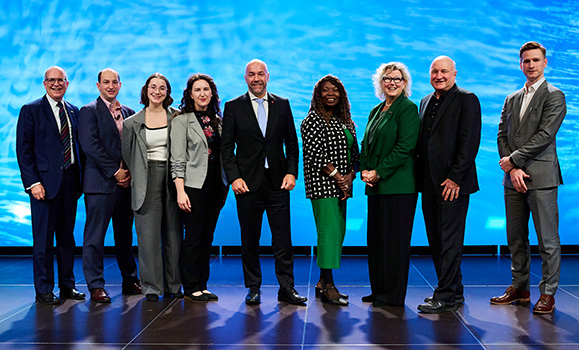Last Wednesday night (November 13), the ballroom at the Halifax Convention Centre was lit up ŌĆö╠²with decorative green and yellow lights, with enthusiasm for renewable energy, with a vision for a greener future.
The occasion was the Halifax Chamber of CommerceŌĆÖs annual fall dinner, with nearly 500 members of the cityŌĆÖs business community in attendance. Over dinner, they heard a suite of talks about Halifax-based efforts to deliver clean energy locally, nationally, and globally.
 ╠²
╠²
And Dalhousie was centre stage.
ŌĆ£Nova ScotiaŌĆÖs clean energy plan is committed to reaching 80 per cent renewables by 2030, and weŌĆÖre not going to get there on imported solutions alone ŌĆö╠²the work starts here,ŌĆØ said Eniko Zsoldos, a PhD candidate in the lab of Dalhousie battery researcher Dr. Jeff Dahn and one of the two co-hosts for the evening.
Charged and ready to go
Dr. Dahn, NSERC/Tesla Canada Industrial Research Chair, was one of the eventŌĆÖs speakers. A leading pioneer in lithium-ion battery technology, his lab is world-renowned for its work to develop batteries for electric cars and grid storage that are cheaper, safer, faster charging, and longer lasting.
Read also: LongŌĆælasting impact: Battery research icon earns top international award (June 2023)
He discussed his longstanding partnership with Tesla (recently renewed until 2031), the continued testing of the so-called ŌĆ£million mileŌĆØ battery, and the opportunities in ŌĆ£V2GŌĆØ ŌĆö╠²vehicle-to-grid.
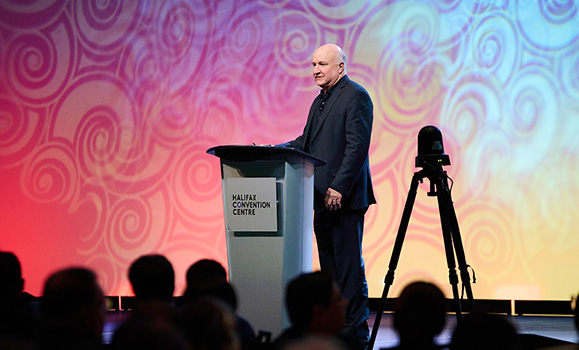
Dr. Jeff Dahn
ŌĆ£If you have a battery strong enough that you cannot wear it out in a vehicle, you can use it for other purposes,ŌĆØ he explained.╠²ŌĆ£When the vehicle is plugged in, it can store energy from the sun or the wind and deliver it back to the grid when those are not available.ŌĆØ
Dr. Dahn also shared with attedees a quick look at the forthcoming Dal-based Canadian Battery Innovation Centre, a new $20-million facility announced earlier this year with funding from the National Reserach Council, the Canada Foundation for Innovation, ACOA, Emera Inc., Tesla and other partners and expected to open in 2026.
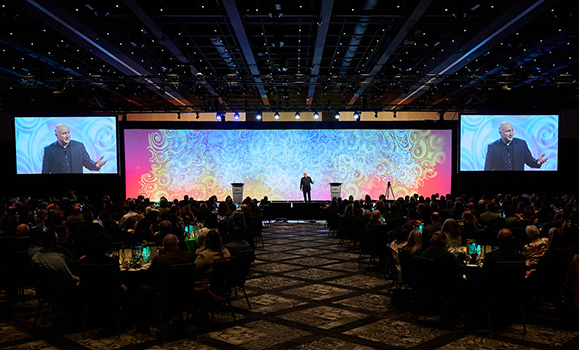
Chamber Dinner guests watch Dr. Dahn's presentation.
Read more: Powering up: FirstŌĆæinŌĆæCanada battery innovation centre to provide critically needed facility for research and industrial development (March 2024)
ŌĆ£Any startup across the country or any university lab can come and use this labŌĆ” It will be right at Dalhousie University and open for business.ŌĆØ ╠²
Growing industrial success in Nova Scotia
The event featured two industry speakers highlighting just some of whatŌĆÖs happening in Nova Scotian clean energy: Dr. Chris Burns of and Matt Borys of .
Dr. Burns, a Dalhousie PhD graduate, co-founded Novonix in 2013 building off of the work he had done in Dr. DahnŌĆÖs lab. While still based in Halifax, the company now also has an extensive facility in Chattanooga, Tennessee as it manufactures ultra-high precision charger systems for battery research and manufacturing labs globally.
Read also: Spotlight ŌĆö Chris Burns (Dal Magazine, FW'22)
ŌĆ£The biggest battery companies in the world, and they do work here in Nova Scotia,ŌĆØ said Dr. Burns, who talked about his companyŌĆÖs development in relation to the basic science at its core.
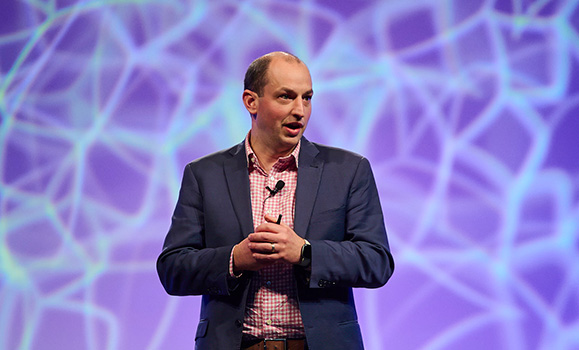
Dr. Chris Burns
ŌĆ£ItŌĆÖs all been about developing IP and patents for work that all stems back to the need to continue to invest in research and development," he said. "And that's why I've been so excited to see Jeff's lab continue to grow over time, and to have more people enter our industry ŌĆö students and postdocs to tackle new problems that we're going to continue to face as we grow the industry."
Matt Borys is vice-president of corporate development at EverWind, North AmericaŌĆÖs leading independent green hydrogen developer. While hydrogen fuel is often used in a wide variety of large-scale industrial processes, it requires CO2 to separate hydrogen from oxygen. In contrast, green hydrogen uses a process called╠²electrolysis to achieve this without fossil fuels.
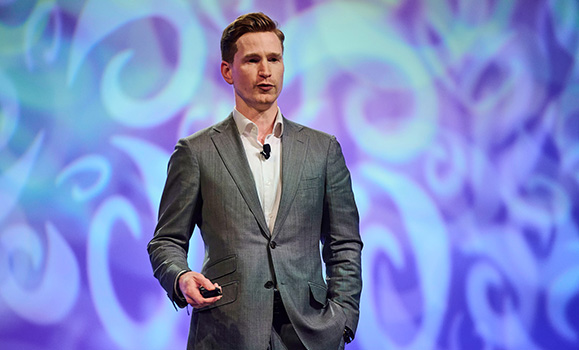
Matt Borys
"What's interesting, what's new and revolutionary is the process and being able to do that process in commercial scale," said Borys, who argued Nova Scotia is ideally positioned to be a global player in green hydrogen for a variety of reasons, including its strong natural resources (particularly in wind power), its promity to Europe ("the spark plug of the industry") and, perhaps most of all, its people. ╠²
"You need a lot of people and a lot of smart people rowing in the same direction. It's great to have the ecosystem we have with Dalhousie, the schools, universities and the technical expertise that often gets underappreciated ŌĆö the same skill set we've been shipping off to Alberta to work in oil and gas, those are the folks that we can bring back home and that we can use here."
Supporting a green energy ecosystem
Dalhousie has a number of connections to the emerging green hydrogen industry, from a collaboration between Dr. Michael Pegg's lab and the Nova Scotia-based Eastward Energy to a two-year National Research Council project, co-led by Drs. Mita Dasog and Michael Freund that is poised to enhance the region's green hydrogen foundations by studying affordable catalysts for production.
"For every new sector built around an innovation, there's almost always a university attached," said Dr. Alice Aiken, Dalhousie's vice-president research and innovation. "There's a reason for this: universities are part of an ecosystem designed to ensure research discoveries benefit society.ŌĆØ
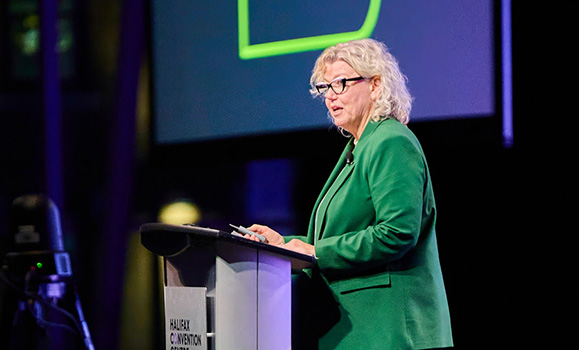
Dr. Alice Aiken
Dr. Aiken's speech tied together many of the evening's themes, exploring the wide-ranging connections involved in transforming research discoveries into real-world applications ŌĆö and illumating how many of those connections can be traced back to universities like Dalhousie.
"We're home to leading edge research, an innovation ecosystem with a successful track record of promoting commercialization, highly specialized talent from around the world, and a long history of partnering with industry to fuel enterprises," she said.
The event appeared to leave the capacity crowd energized with a sense of possibility and potential for what green energy could mean for Nova Scotia's future ŌĆö summed up well by co-host Dr. Sarah Martell, a Mitacs postdoctoral researcher who has worked with Dr. Dasog's lab.
"This is a place that has built ships, dug coal, cultivated forests ŌĆö╠²and now weŌĆÖre taking the lead in figuring out how to fuel a better life for everyone... Whether youŌĆÖre already connected into the green energy industry or not, this is an emerging economy where thereŌĆÖs space for everyone to get involved."
